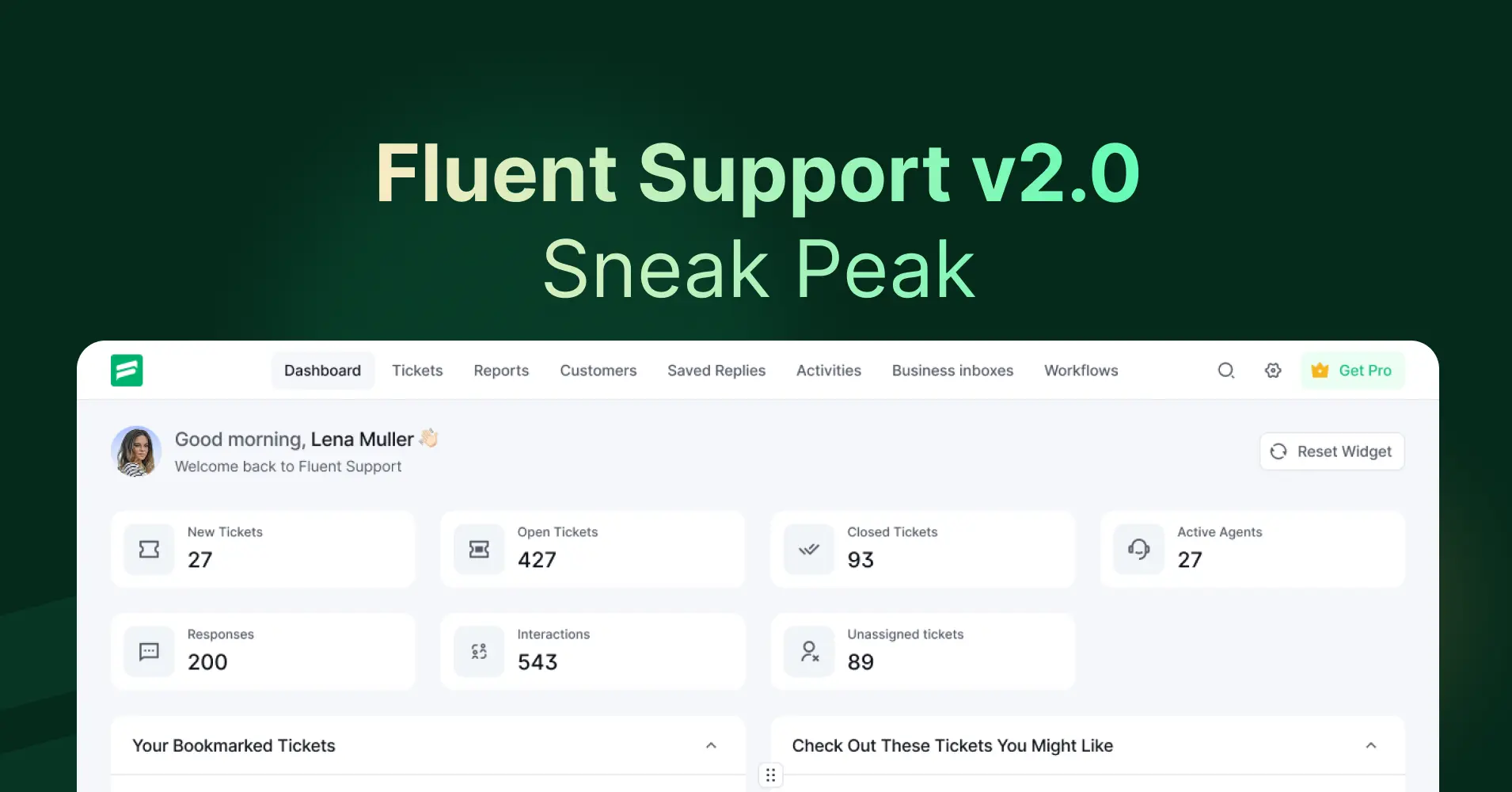
Fluent Support v2.0: Sneak Peak
By Shahjahan Jewel
November 19, 2025
Last Modified: November 25, 2025
Fluent Support quietly turned four (4) this November. Four years may not seem long in the life of a product, but in support where expectations evolve, new channels emerge, and compliance rules shift every year, it’s as good as a lifetime.
Today, Fluent Support powers 10,000+ businesses, from small agencies to enterprise-grade WordPress ecosystems. They rely on us not as a “plugin,” but as part of their daily operational backbone.
The weight of this responsibility is huge! And that sense of responsibility is the reason this update exists.
As Fluent Support grew, so did the diversity of the people using it:
- Support agents who live inside the inbox eight hours a day.
- Managers tracking performance across multiple teams.
- Businesses expanding into multilingual regions and strict compliance frameworks.
- Startups scaling from 20 to 2,000 tickets in a matter of months.
We’re finally ready to take this diverse user base and introduce Fluent Support to the next level of evolution.
Enter Fluent Support v2.0.
A Vision Born Out of Necessity
Before Fluent Support was a commercial product, it was something we built because we had to. Our own team was growing. SaaS tools weren’t flexible enough. And most self-hosted support solutions in the WordPress space felt like relics of a different era.
We needed something fast, something agent-centric, something we could truly own.
So we built it. And the moment we deployed the earliest version internally, we knew the WordPress community had been waiting for the same thing.
Self-hosted shouldn’t mean “dated.”
WordPress shouldn’t mean “limited.”
Owning your data shouldn’t mean sacrificing modern UX.
That belief is the core of Fluent Support. And it’s the engine behind Fluent Support v2.0.
The Journey So Far: 45 Updates, Dozens of New Features, and a Lot of Listening
Four years in, it’s easy to say we’ve shipped “45 updates.”
But the number is meaningless without context.
Those 45 updates reflect:
- rebuilding internal logic to support larger teams
- rewriting how conversation lists load to cut milliseconds
- making workflows predictable for agents juggling hundreds of tickets a day
- adding integrations because users needed their support desk to be the center of operations
- making everyday actions safer, faster, less repetitive
- and a plethora of features too large in number to list here.
However, these updates were never just about “features.”
They were about supporting the people behind them. The ones who spend their entire day helping others.
Over time, the product grew. But one thing became increasingly clear:
Our interface wasn’t keeping up with the complexity and maturity of the teams using Fluent Support.
What We Learned by Serving Others
Fluent Support didn’t grow just because of marketing. It grew because users told other businesses, “this is the support desk that finally makes sense.”
Through that growth, we learned a few critical truths:
1. SaaS isn’t the default anymore — autonomy is
More businesses today want control, not subscriptions. Ownership of data, flexibility in workflows, and the ability to comply with internal and external policies. These aren’t “nice to have” features anymore, they’re what businesses are actively seeking out.
A self-hosted support desk isn’t a niche option. It’s becoming the preferred operational model for teams on a serious growth spurt.
2. Compliance isn’t “optional admin work” anymore
Every year brings new regulations!
GDPR, UK-GDPR since Brexit, California privacy rules, region-wise storage requirements, data-retention policies. SaaS adds layers of uncertainty. Self-hosting simplifies the equation. Instead of reading 5 separate T&C documents, just keep your data on your server. And businesses told us they want that level of clarity.
3. The WordPress UI aesthetic has reached its limit
Support teams demanded more than the classic WP admin look.
They wanted:
- Calmer screens
- Modern spacing
- Better grouping
- Consistent actions
- Fewer “surprises” in navigation patterns
They wanted a support desk that looked like a modern SaaS tool, without compromising the self-hosted edge.
4. The experience needed to support long hours, not occasional visits
Support agents don’t “drop in” to the inbox. They live in it.
Comfort matters whether it’s typography, line height, side panel structure, button placements, scroll behaviors; these elements affect productivity, fatigue, and customer response quality. We needed to re-optimize everything through that lens.
What We Know We Didn’t Get Right
1. ElementUI helped us scale fast, but limited how far we could push refinement
It gave us speed, but not the design nuance or flexibility that complex support workflows require.
2. Our UI didn’t fully respect the “long session” use-case
Support tools aren’t dashboards you check for five minutes. They’re operational workspaces. The UI must feel stable, breathable, and predictable.
3. Information architecture needed rethinking
Some pages were overloaded. Some were too sparse. Critical insights took too many clicks to uncover.
4. Our reporting served our internal needs, not the full range of teams using FS
Support leaders need visibility. They need trendlines, bottlenecks, agent performance breakdowns, and workload insights. Our initial reporting foundation didn’t scale with the variety of users we gained.
We took this seriously and fixed it!
Moving Forward: Introducing Fluent Support 2.0
FS 2.0 isn’t a cosmetic refresh. It’s a re-architecture of how support should feel inside WordPress.
Thinking Beyond the WordPress UI
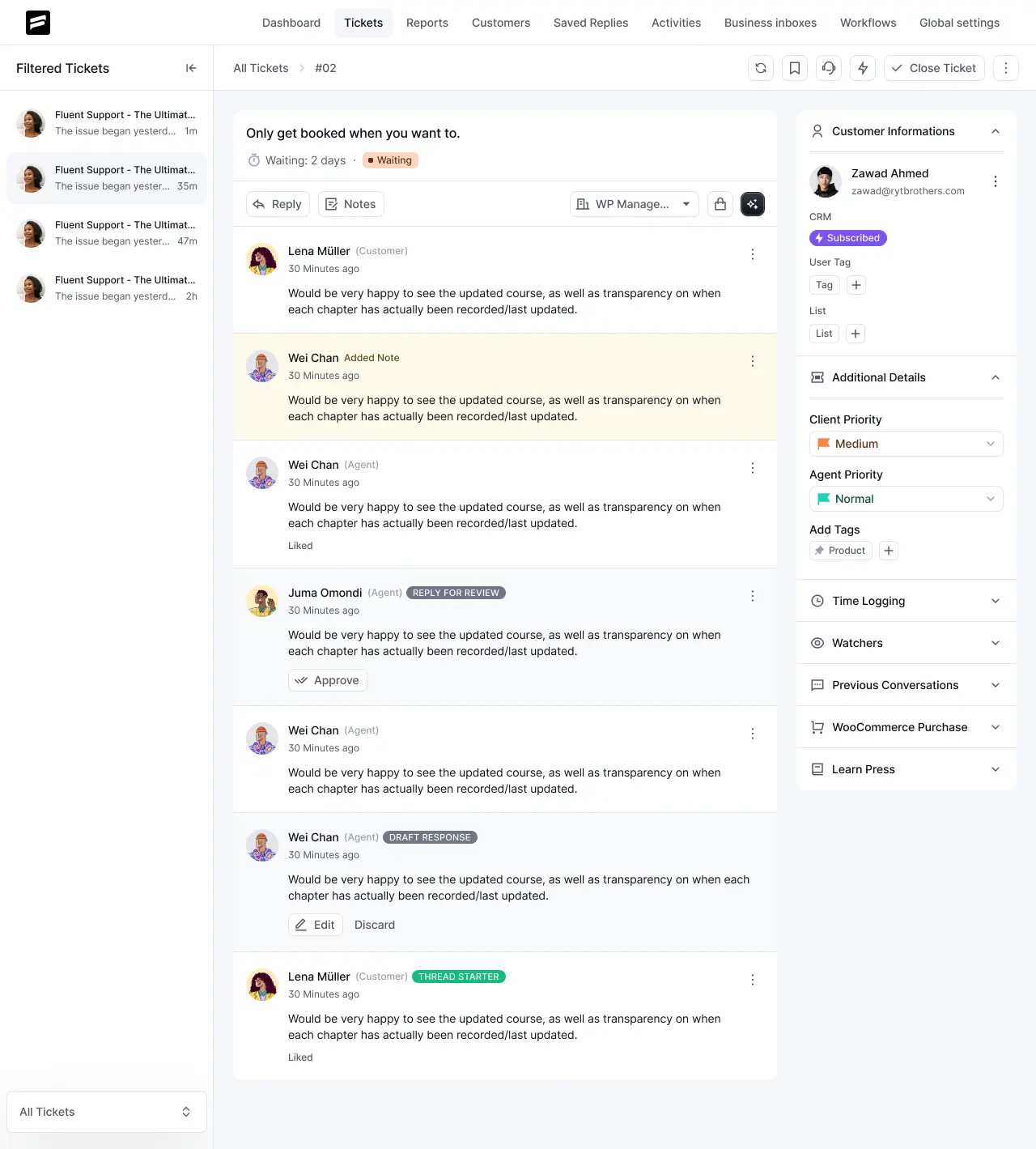
We stepped outside the boundaries of the classic WordPress admin and built a design language tailored for modern support workflows.
You’ll notice:
- a cleaner, calmer visual grid
- new spacing logic for long-hour comfort
- consistent actions across the entire product
- sleeker components and refined interaction states
- better grouping of information, based on real usage patterns
- accessibility improvements across customer- and agent-facing surfaces
- a visual style that stands shoulder to shoulder with leading SaaS platforms
This isn’t “WP admin with colors.” It’s a modern support interface built inside WordPress but not limited by it.
Improved Reports and Added Visibility
Reporting has been rebuilt with an entirely new philosophy.
Instead of asking, “What can we show?”, we asked, “What do teams need to make better decisions?”
You’ll find:
- clearer breakdowns of agent activity
- visibility into slowdowns and ticket choke points
- insight into spikes and seasonality
- improved response-time tracking
- better categorization of ticket sources
- more consistent labeling and visual patterns
Support leaders finally get a bird’s-eye view that matches real operational needs.
Refreshingly Familiar
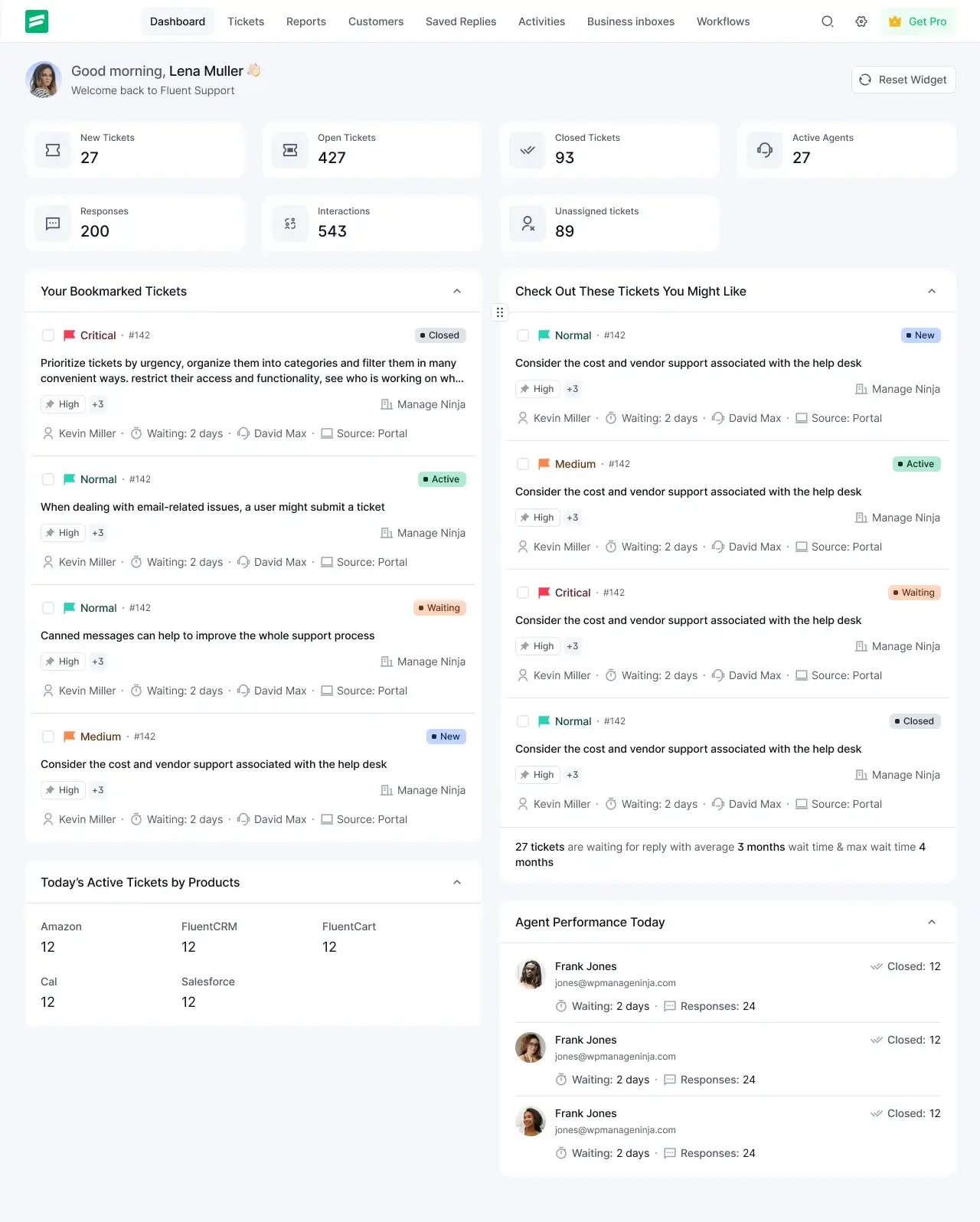
While FS 2.0 feels modern, polished, and significantly more refined — your workflows remain intact.
We didn’t want a redesign that forced relearning.
So the new interface is:
- visually elevated
- more consistent
- faster to navigate
- more logical across sections
- designed to reduce friction
…while keeping the core structure familiar.
It feels like Fluent Support, just significantly better.
A New Motto for This Update
Modern UI, Self-Hosted Control.
This is the crossroads the industry is moving toward. SaaS tools set design standards, but businesses want ownership and autonomy. Self-hosted systems offer control, but historically lacked polish.
Fluent Support 2.0 closes that gap.
You no longer have to choose between a modern experience and a self-hosted foundation. You can have both — without compromise.
A New Chapter Begins
This sneak peek is just the beginning. We’ll soon publish a deeper look at the design language, the architectural improvements, and the principles guiding v2.0.
Fluent Support 2.0 isn’t an update.
It’s a statement about where the support industry is heading and what self-hosted platforms can (and should) deliver.
To everyone who trusted us these past four years, thank you. We’re building this next version with you, for you, and because of you.
More updates soon.





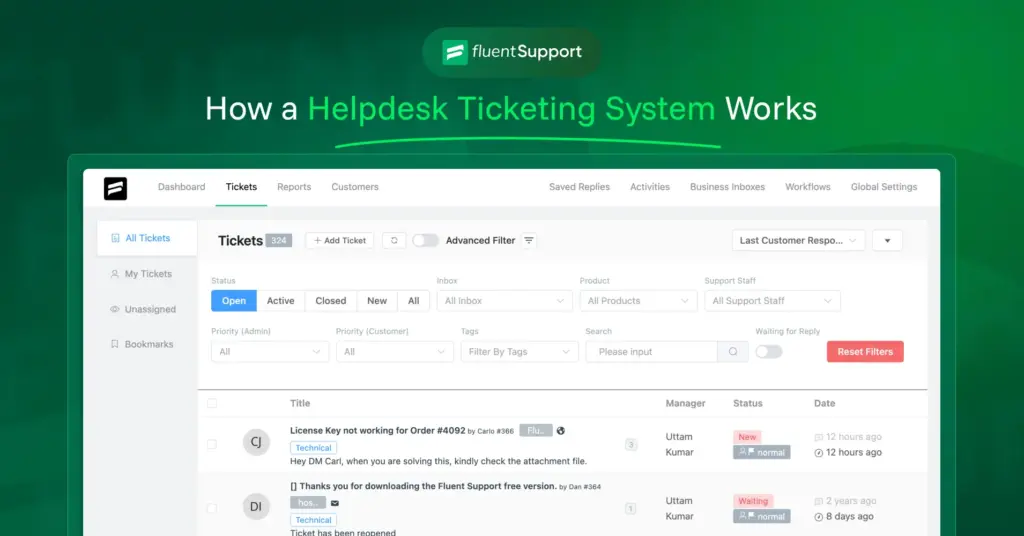


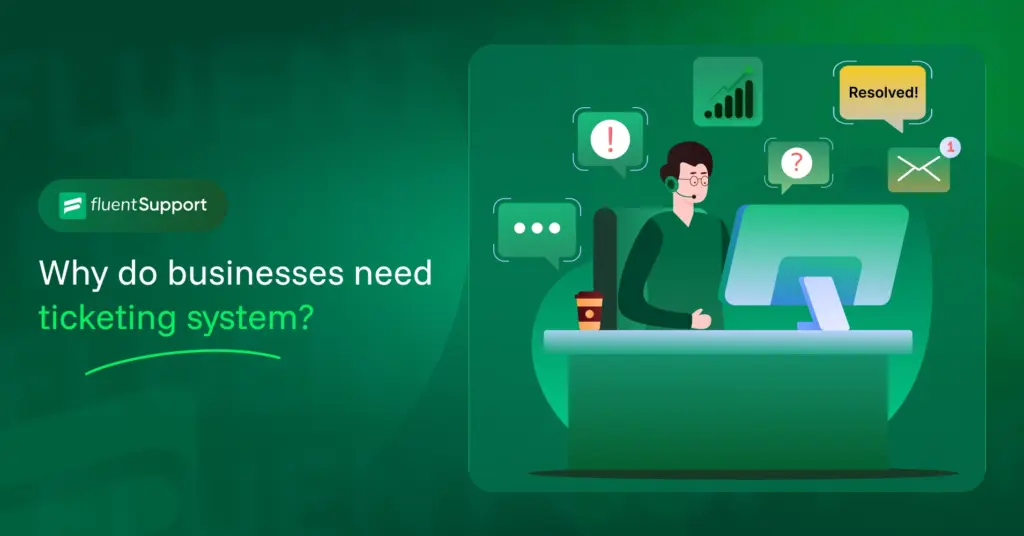



Leave a Reply